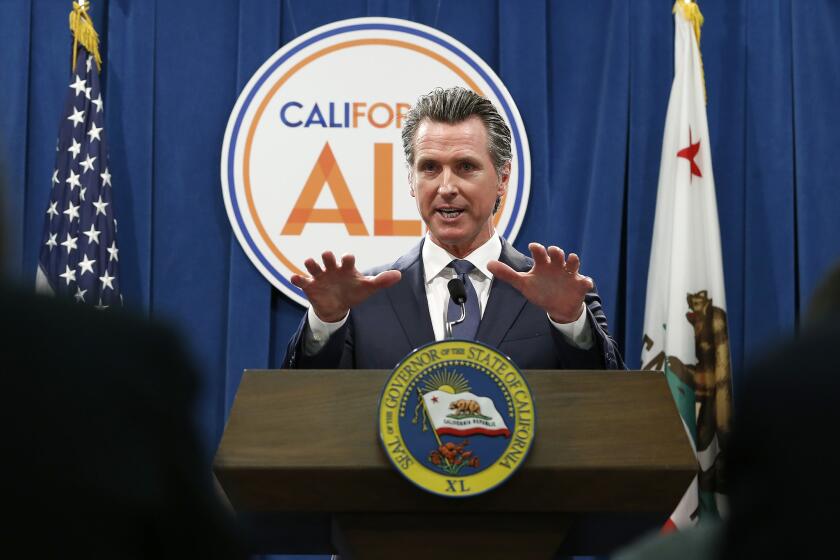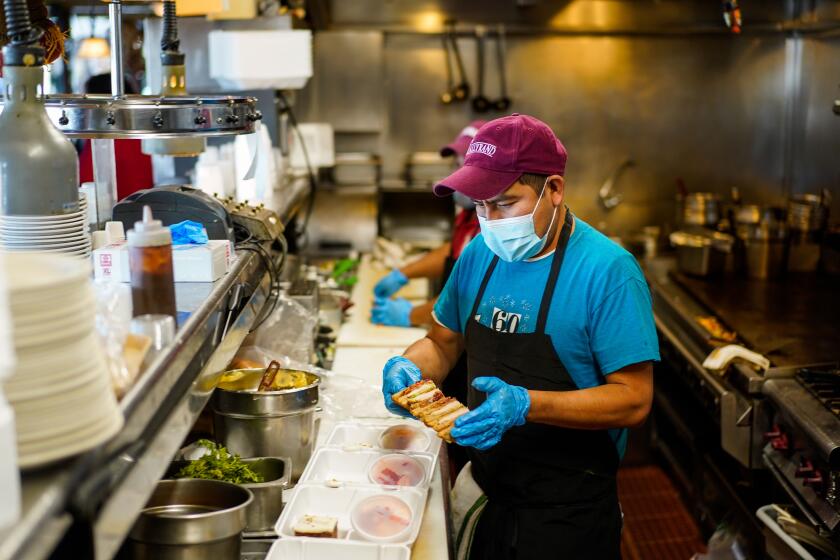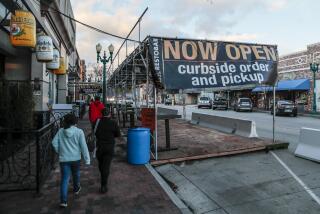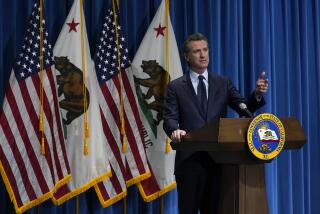California’s new stay-at-home order: What you need to know, from supermarkets to playgrounds
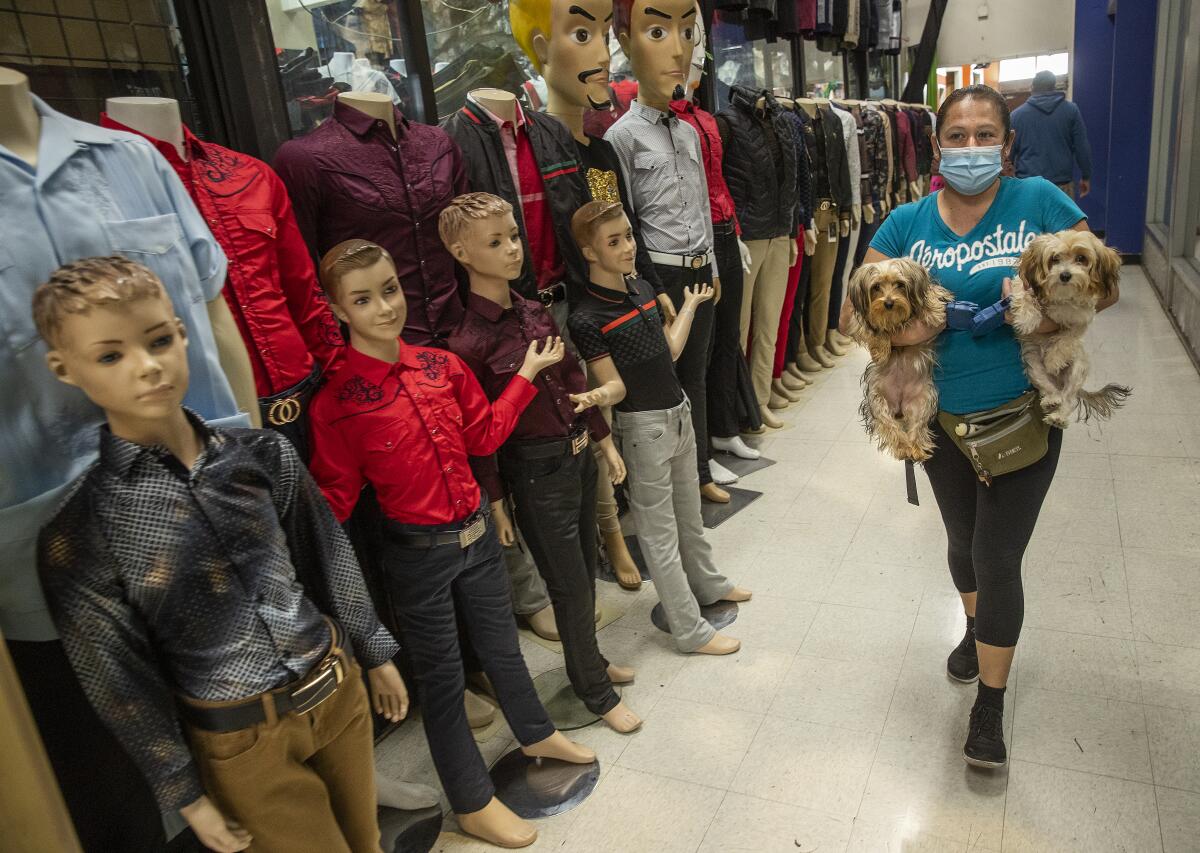
Gov. Gavin Newsom’s new regional stay-at-home order is similar to the original sweeping order issued in March, but is significantly limited in some ways.
All retail stores will be allowed to remain open, as will outdoor spaces like parks and beaches.
For the record:
9:05 a.m. Dec. 4, 2020An earlier version of this article indicated essential retail capacity in Los Angeles County would be capped at 20% capacity, dropping from 25%. Current capacity for essential businesses in L.A. County is 35%.
Additional closures of California businesses and activities will be based on projections of regional intensive care unit capacity.
The order prohibits gatherings and requires people to stay home and minimize their interactions with other households as much as possible. The practice of keeping people physically distant from one another interrupts the transmission of the virus.
Nearly 20,000 Californians have died after being infected with the coronavirus, responsible for the worst global pandemic in more than a century. State officials are forecasting that intensive care units will exceed capacity within weeks, which could worsen mortality in hospitals. Unless the current surge in cases is turned around, California’s death toll could double by the end of winter.
Here’s how the new order works.
When the stay-at-home order goes into effect
Where: A stay-at-home order would be implemented by region, triggered when the region’s intensive care unit capacity falls below 15%.
When: The order would go into effect 24 hours after a region hits the ICU capacity threshold. On Friday, five counties in the Bay Area — San Francisco, Santa Clara, Alameda, Contra Costa and Marin — said they planned to implement the order early next week, without waiting for the region to hit the state’s threshold.
How soon: The earliest any region could see closures would be Sunday.
What are the regions? There are five: Southern California, the San Joaquin Valley, the Bay Area, the Greater Sacramento area and rural Northern California.
Projections: On Friday night, two regions — Southern California and the San Joaquin Valley crossed the threshold, which, if it continues on Saturday, would cause the stay-at-home order to be implemented in those regions by Sunday.
Here’s the current available ICU capacity by region, based on actual numbers, according to the California Department of Public Health, as of Friday night.
Bay Area: 21.2%
Greater Sacramento Region: 21.4%
Rural Northern California: 20.9%
San Joaquin Valley: 14.1%
Southern California: 13.1%
The percentages change daily as intensive care units admit and release patients, according to the agency.
What closes once a region hits this threshold
- Outdoor restaurant dining
- Hair salons, barbershops, nail salons and other personal care services
- Playgrounds
- Outdoor cardrooms and satellite wagering and casinos
- Outdoor museums, zoos and aquariums
- Outdoor movie theaters
- Outdoor wineries
- Overnight stays at campgrounds
- Food, drink or alcohol sales at outdoor recreational facilities
Retail would stay open, but with more limited capacity
This is a major difference — all retail would be allowed to remain open under this stay-at-home order, although at a reduced capacity. Counties can impose tougher rules than the state’s.
- Most of California: In much of the state, essential retail, like supermarkets and drug stores, were allowed to open at 50% of capacity; non-essential retail, like other stores and malls, opened at 25% capacity. The new order would lower capacity of all retail to 20%.
- Los Angeles County: L.A. County on Monday already had tightened capacity limits at retail. When L.A. County falls into the scope of the new order, nonessential retail capacity limits would remain the same at 20%. Essential retail capacity would fall from 35% of capacity to 20%.
- Santa Clara County: Santa Clara County also had already tightened capacity limits. When the county falls into the scope of the new order, the local, tougher limit for nonessential retail (10%) will be loosened to conform with the state’s limit, 20%. Essential retail capacity would fall from 25% to 20%.
- Shopping centers would also be capped at 20% of capacity. Eating and drinking in stores would be prohibited. Special hours should be imposed for seniors or those with compromised immune systems.
Travel and use of hotels and lodging for tourism and leisure prohibited
After the first statewide stay-at-home order imposed in the spring, California allowed counties to reopen hotels for tourism and individual travel in June.
The new regional stay-at-home order, when effective, again prohibits hotel use for tourism, leisure and other nonessential reasons, like nonessential travel, whether it be a vacation or a road trip to see family or friends.
Specifically, it allows hotel and lodging for essential reasons only, defined as supporting “critical infrastructure sectors,” , including workers in healthcare, food, agriculture, energy, utilities, transportation, communications, government operations, manufacturing, financial services and the entertainment industry.
The order would prohibit nonessential travel.
What stays open
- Entertainment production
- Professional sports without live audiences, except for Santa Clara County. It has its own order banning contact sports, which has forced the San Francisco 49ers to temporarily relocate their team to Arizona for its December home games
- Schools that are already open for in-person learning can remain open
- Outdoor areas like beaches, parks, and hiking trails
- Medical offices, dentist offices
- Childcare and prekindergarten
- Restaurants for takeout and delivery service
- Critical infrastructure sectors
Gatherings would be banned
In early October, the state began to allow counties to permit small gatherings of people from different households, provided they occurred outdoors for a duration of no more than two hours and involved people from three or fewer households, who stayed at least six feet from one another and wore masks when not eating or drinking.
The new order would prohibit gatherings among people from different households. L.A. County implemented the same ban on Monday.
Outdoor church services and political demonstrations are still allowed. How long do regions stay under the order?
Regions stay under the order for at least three weeks.
To be released, the region must have its area’s forecasted ICU capacity for the next four weeks reach 15% or greater.
The counties then return to the existing reopening tier system, determined by the coronavirus case rate and test positivity rate, to determine what industries can reopen.
Los Angeles issued a modified stay-at-home order Wednesday night mirroring new L.A. County rules. “Just be smart and stay apart,” Mayor Garcetti said.
How will it be enforced?
Realistically, the order will work only if most Californians comply.
Newsom said he’s seen support for enforcing the order from a number of local officials, although he acknowledged that some officials have said they’re not planning to enforce the rules. Newsom said among counties unwilling to enforce rules or adopt measures to reduce the spread of disease, he plans to withhold funding set aside to address the pandemic.
What about travel?
California issued a travel advisory last month that urged against nonessential out-of state trips and asked people to quarantine for 14 days after arriving from another state or country.
Now that the regional stay-at-home order is expected to be in place soon, “we’re asking people then to consider canceling their travel plans now,” Ghaly said.
Once the order goes into effect, the state is asking people to stay at home and not mix and move around. Part of the recent surge in California, Ghaly said, was caused by travelers coming to California from other areas.
“All nonessential travel we are ordering to be temporarily restricted,” Newsom said.
The directive to cancel nonessential travel plans is a requirement, not an advisory. The requirement really isn’t enforceable, but Ghaly said he hoped that labeling it a requirement would encourage compliance. Why use a regional approach?
The regional approach is being used because that’s how hospitals and healthcare delivery systems work when some hospitals reach capacity, Ghaly said. When one county is full, it leans on a nearby county for help.
Rural Northern California: Del Norte, Glenn, Humboldt, Lake, Lassen, Mendocino, Modoc, Shasta, Siskiyou, Tehama, Trinity
Bay Area: Alameda, Contra Costa, Marin, Monterey, Napa, San Francisco, San Mateo, Santa Clara, Santa Cruz, Solano, Sonoma
Greater Sacramento: Alpine, Amador, Butte, Colusa, El Dorado, Nevada, Placer, Plumas, Sacramento, Sierra, Sutter, Yolo, Yuba
San Joaquin Valley: Calaveras, Fresno, Kern, Kings, Madera, Mariposa, Merced, San Benito, San Joaquin, Stanislaus, Tulare, Tuolumne
Southern California: Imperial, Inyo, Los Angeles, Mono, Orange, Riverside, San Bernardino, San Diego, San Luis Obispo, Santa Barbara, Ventura
More to Read
Sign up for Essential California
The most important California stories and recommendations in your inbox every morning.
You may occasionally receive promotional content from the Los Angeles Times.
